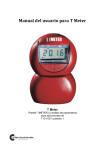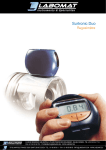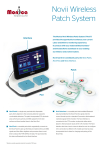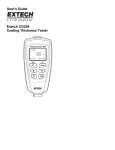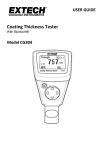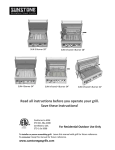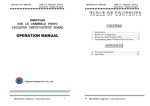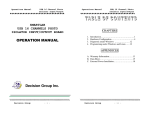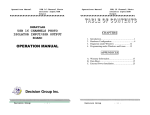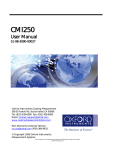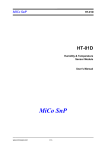Download User`s Manual for The T Meter
Transcript
User’s Manual for The T Meter T Meter Part #: TMETER (3 parameter model) www.aciconcrete.net T101-001 Issue 1 Table of Contents Getting Started 5 Changing Batteries 6 Making a Measurement 7 Calibrating the Meter 8 Set Up Procedure 9 Error Codes 10 Specifications 11 2 Caution The pick-up is extremely sensitive to shocks. When positioning the instrument onto the Surface to be measured, carefully place the pick-up onto the surface to avoid damage. When positioning the pick-up onto the calibration standards surface, ensure that is positioned over the surface to measure as shown. Direction of pick up travel Direction of pick up travel REFERENCE SPECIMEN Ra = 5.81 µm Calibration standard Calibrate using this area 3 Control Unit Release button Start button Start button Mode status Display Parameter status Mode selector Parameter selector Traverse Unit IrDA windows Stylus Stylus On button 4 Getting Started Storage. The T Meter is supplied in its storage configuration, that is with the Traverse Unit connected to the Control Unit so as to protect the gauge. Before use, it is necessary to separate the Traverse Unit from the Control Unit. Note: In order to prevent damage to the stylus, it is recommended that the unit is stored in the storage configuration when not in use. To return the unit to its storage configuration, reverse the above procedure. Control Unit To separate, press here and tilt the Traverse Unit to separate as shown. Traverse Unit Positioning Position the Traverse Unit on the surface to be measured as shown. Inserting the batteries The T Meter uses four 3V Lithium 2450 batteries, one in the Control Unit and three in the Traverse Unit. To insert the batteries, remove the battery covers as shown. Insert the new batteries as shown, taking care to observe the correct polarity. Replace the battery covers. After replacing the batteries there will be a short delay following switch on before normal operation resumes. 5 Removing the batteries If the T Meter is not going to be used for an extended period of time, it is recommended that the batteries are removed from both the Control Unit and Traverse Unit. To remove the battery from the Control Unit, remove the battery cover and then press on the edge of the battery at a point adjacent to either of the two cut-outs in the moulding as shown. The battery can then be tipped out of the Unit. Replace the battery cover. To remove the batteries from the Traverse Unit, remove the battery cover and then press down on the edge of the battery closest to the centre-line of the Unit. The top battery can then be slid out of the battery compartment. The remaining batteries can be removed by tipping them out of the Unit. Replace the battery cover. Battery Disposal WARNING: DO NOT ATTEMPT TO RECHARGE THE BATTERIES. USED BATTERIES MUST BE DISPOSED OF SAFELY IN ACCORDANCE WITH LOCAL REGULATIONS. DO NOT INCINERATE. Battery low indication During a measurement, if the battery power in either unit is low, then a low battery indication will be given. The following displays are used to indicate a low battery condition and to identify the affected unit. Traverse Unit battery low Control Unit battery low 6 Switching on The Control Unit is powered whenever the batteries are in place. The unit automatically enters a power saving mode after five minutes from the last operation. During power saving mode the display is turned off. To activate the unit, press any button. The display will be activated again and the welcome screen displayed. The Traverse Unit automatically enters a power saving mode after five minutes from the last operation. In this mode a minimal current is drawn, sufficient only to maintain the power control circuitry. To reactivate the Traverse Unit press the On button. An LED on the side of the Unit flashes to confirm activation. Making a measurement There are two modes for operating the T Meter: Connected Mode and Remote Mode. Connected Mode. In connected mode the Control Unit is connected to the Traverse Unit as shown before the measurement is made. To connect the Control Unit to the Traverse Unit, insert the Control Unit as shown and tilt until the latch engages. Remote Mode. In remote mode the Control Unit is positioned within 1m of the Traverse Unit and data is passed between the two units over the IrDA link. Note: The alignment between the Traverse Unit and Control Unit must be maintained throughout the measurement process. 7 Operation of the Control Unit is identical, whether the system is in Connected mode or Remote mode. On the Control Unit use the Select Parameter button to select the parameter that is required to be displayed upon completion of the measurement. Use the Select Mode button to select either metric or inch units as required. Position the Traverse Unit on the surface to be measured. If using remote mode, ensure that the line of sight between the infra red transceivers is unobstructed; maintain the line of sight throughout the measurement. To begin the measurement press either of the Start buttons. During the measurement the Control Unit will show the ‘measurement in progress’ display. Upon successful completion of a measurement the measured parameter is displayed as shown. Should an error occur during measurement an appropriate E code will be displayed. All parameters (not just the selected parameter) are transmitted to the Control Unit at the same time and temporarily stored. The stored results may then be stepped through using the Select buttons. Calibrating the gauge To ensure accuracy of results, it is recommended that the T Meter be calibrated periodically using the calibration specimen supplied with the instrument. Position the Traverse Unit to measure the Calibration Standard supplied with the instrument ensuring that the traverse is parallel to the edge of the standard and entirely over the structured surface. DO NOT use any other standard. Direction of pick up travel REFERENCE SPECIMEN Ra = 5.81 µm Calibrate using this area Calibration standard 8 On the Control Unit press the Mode Select buttons until √ is indicated on the Mode status. Press the Start button on the Control Unit. This will initiate the gauge calibration procedure. At the end of the calibration procedure the Control Unit will display the results of the calibration. The Ra value should be 5.81μm and the Rz value 21.5μm. If an error occurs an E code is displayed. Set Up Procedure The T Meter is set up before leaving the factory. The set-up procedure is used to set the speed of the traverse unit and the gain of the gauge. Normally it is only necessary to repeat the set-up procedure after changing the pick-up. However, if it is required to set up the unit after purchase, the following procedure should be used. Separate the units ready to use them in Remote Mode. Turn on the traverse unit and position it on the calibration standard as shown above. Activate the Control Unit. With the Control Unit pointing at the IrDA window on the Traverse Unit, press and hold both selector buttons simultaneously and then press the right-hand start button whilst still holding the selector buttons. This will initiate the set-up procedure. Once the procedure has started, release the buttons. Note that the infra-red link must be maintained throughout the procedure, which takes about a minute. During the procedure, the display will show the following Sequence. The control unit must be kept pointing at the traverse unit during this period. Upon successful completion of the set-up procedure, the display will show a value. There are three values stored as follows: Value 1 – Ra (Roughness Average) Value 2 – Sp (Concrete Surface Profile – CSP) Value 3 – STG (Surface Texture Grade) These values can be viewed by toggling the display using the right-hand Selector button. Should an error occur during set-up, the procedure will terminate and an E code will be transmitted to the control unit for display. “After executing the set-up procedure, the instrument should be calibrated before making any measurement.” 9 E codes The following E codes may appear on the display during the course of using the T Meter. E=1. E=2. E=3. E=4. E=5. E=6. E=7. E=8. E=9. E=10. E=11. E=12. E=13. E=14. Infra Red communication error. This might be caused by loss of the line of sight between the two units or other interruption of the infra-red connection. – Repeat the operation. Measurement attempted when not calibrated. Calibrate the Traverse Unit. Traverse Unit - Oscillator fault - Re-attempt the operation. If the fault persists, return the T Meter to a ACI or Taylor Hobson Service Centre for servicing or repair. Traverse Unit - Motor Positioning fault - Re-attempt the operation. If the fault persists, return the T Meter to a ACI Service Centre for servicing or repair. Traverse Unit - NVRAM Error - Re-attempt the operation. If the fault persists, return the T Meter to a ACI Service Center for servicing or repair. Profile Over-range. The surface being measured may exceed the measurement range of the T Meter. Reattempt the measurement. Parameter Over-range. The surface being measured may exceed the measurement range of the T Meter. Re-attempt the measurement. Traverse Unit - Motor Speed Setup error. Check that the traverse is parallel to the edge of the calibration standard, then re-try the set-up procedure. Traverse Unit - Gain Setup error. Check that the traverse is entirely over the structured area of the standard. Re-attempt the set up procedure or calibration procedure Control Unit - Oscillator fault - Re-attempt the operation. If the fault persists, return the T Meter to a ACI Service Center for servicing or repair. Traverse Unit - Calibration information download error. Repeat the calibration procedure. Traverse Unit - Not set up or set-up information lost. Run the Set up procedure. <Reserved> Traverse Unit - Electronic Measurement error – Re-attempt the operation. If the fault persists, return the T Meter to a ACI Service Centre for servicing or repair. 10 Specification Traverse length. Measurement length Traverse speed Gauge range Gauge resolution Display resolution Display resolution Cut off Uncertainty Results range Results range Stylus Filter type Sample spacing Stylus Force Batteries Units Operating conditions Size Weight 5mm (0.2in) 4mm (0.16in) 2mm/s (0.08in/s) 200μm (8000μin) 0.05μm (2μin) Ra. 0.01μm (1μin) Sp, STG 0.1μm (1μin) 0.8mm (0.03in) +/- 15% 0.1μm (4μin) or 5% of result, to 95% confidence level Ra 40μm (1600μin), see ISO 4287:1997 Sp, STG. 199.9μm(8000μin), see CSDA ST115 Diamond conisphere with 5μm nominal radius, 90º tip angle. Skid radius: 10mm nominal. 2CR, (200:1) 1um 10mN (1gf) max at mid range Control Unit One x 3V Lithium 2450. Traverse Unit: Three x 3V Lithium 2450 μm or μin 10 to 35ºC, 80%RH non-condensing 125mm x 80mm x 38mm (4.92in x 3.15in x 1.5in) 200g (7oz) *3 parameter model only Protected by US Patent No 6629373 and US Design Patent No D439850 Infra-red communications link The range of the infra-red (IR) link may be reduced in strong lighting conditions or where there is interference at the specific wavelengths or frequencies used by the IR devices. Sources of such interference include some fluorescent lighting products. If operation is affected by such conditions, it may be necessary to reduce the distance between the two units, shield the infra-red ports from the stray light or use the Duo in its Connected mode. Disposal of the Surtronic Duo When disposing of the T Meter, please remove the batteries as described above. Dispose of the batteries and the instrument independently in accordance with local regulations. The instrument should be disposed of as Waste Electrical and Electronic Equipment (see EU Directive 2002/96/EC) and not put into general waste. Declaration of Conformity Distributor Name: ACI, Inc. Distributor Address: 124 Sidon Rd., Rose Bud, AR 72137 419-408-5906 Manufacturer’s Name: Taylor Hobson Limited Manufacturer’s Address: 2 New Star Road, Leicester, England, LE4 9JQ It is declared that the products: T Meter 168-7092 (3 parameter) conform to all applicable requirements of BS EN 50081-1:1992, BS EN 50082-1:1998 and BS EN 61010:2001. The above product complies with the requirements of the EMC Directive 89/336/EEC as amended. The above product complies with the requirements of the EMC Directive 73/23/EEC as amended. 11 12












